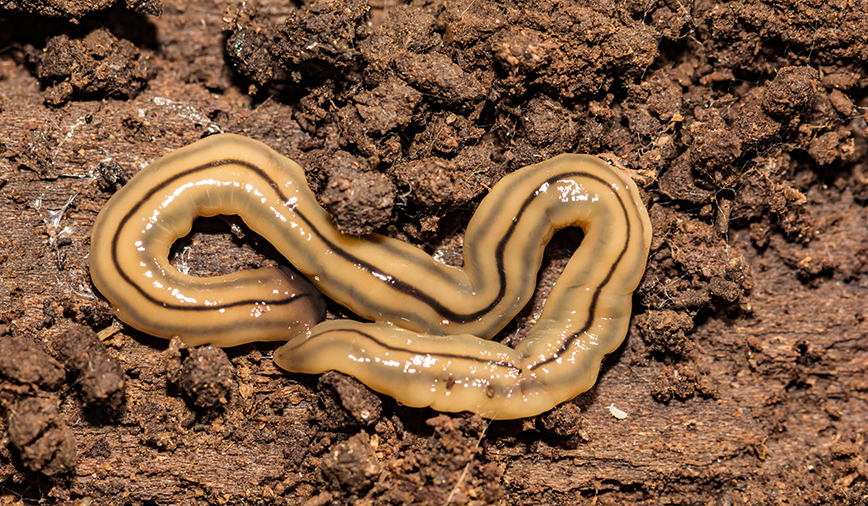October 24, 2014 Hammerhead Worms
Bipalium adventitium, or hammerhead worm, is a predatory planarian with a preference for earthworms. The introduced species, native to Asia, recently was sighted at Delnor Woods in St. Charles.
The great naturalist John Muir once wrote, “When we try to pick out anything by itself, we find it hitched to everything else in the Universe.”
It’s a wonderful quote, and so very true. The thing is, especially in today’s society, we don’t take the time to “pick out” much. And when we do, we usually have no clue of all to which it is “hitched.”
Case in point: A few months ago in this space we took a look at earthworms, a complex of species many folks were surprised to learn is considered exotic, or not native to our area. That column mentioned a few of the connections between worms and certain other nonnative species, such as buckthorn and garlic mustard, that ecologists have noted as the aliens have spread throughout the eastern United States.
As interesting as those examples are, they represent only what we have been able to discover through recent research. Millions of other connections exist, most of which—to us humans anyway—will remain hidden or, at best, poorly understood.
I was reminded of how little we really know just the other day, as I explored the wilds of Delnor Woods Park with a group of fourth graders from Mrs. Carter’s class at Wasco School.
The day was cool and wet; the woods, quiet, save for the patter of light rain on the leaves above our heads. Most of the woodland wildlife was laying low that day, except for a couple of squirrels and about a gazillion earthworms— big ones, little ones and medium-sized ones strewn about the pavement like so many bits of wiggly spaghetti.
The students, parent volunteers and I picked our way along the trail, trying not to squish the wee beasties as we made our way to one field trip station and then another. We were doing pretty well at staying on task—a major accomplishment given the number of appealing distractions that squirmed about our feet—when something odd caught my eye.
There on the wet path, looking very much like the petiole, or stem, of a maple leaf, was a yellowish creature unlike anything any of us had seen before. Slimy and worm-like, it had a triangular-shaped head, and reminded me of the aquatic Planaria we used to study in biology. But this critter was much larger than any Planaria species I remembered. And, despite being wet from the rain, it clearly was a land dweller.
Not wanting to veer too far from our plan for the day, we spent only a few minutes musing over the animal and its possible identity. We snapped a few pictures, then moved on—well, physically, anyway. Mentally, however, my brain was stuck on the weird, wriggly thing. What the heck was it?
It wasn’t until evening that I had time to do some serious Googling to try and track down the creature. I knew that identifying it to species was a pipe dream. But maybe, with a little luck, I could determine at least its taxonomic family.
I typed the term “terrestrial planarian” into the search box and, bingo! A hit on the first try: Geoplanidae, the land planarians. I quickly learned that these flatworms, though they look fairly innocuous, actually are voracious predators of a wide variety of invertebrates.
A few more clicks and I found a genus, Bipalium, that contained some species that closely resembled the creature we’d found at Delnor Woods. One in particular, Bipalium adventitium, looked to me to be a very close match. Another bingo!
After making that connection, the information stream flowed fast and furious. I learned that B. adventitium is thought to be native to southeast Asia, and was introduced to this country accidentally—probably via the soil on the roots of imported plants—sometime in the last 70 years or so.
I also learned that B. adventitium, which also is known by the common name hammerhead worm, preys heavily on earthworms. Aha! No wonder “our” creature was there on the wet, wormy path. It was visiting an all-you-can-eat buffet!
From there, things started to get complicated. I wanted to make the assumption that B. adventitium is a helpful addition, preying on nonnative worms that might be harming our native woodland ecosystems. But the flatworm is pretty ruthless, taking on virtually any and all earthworm species it encounters. Those worms, exotics that they may be, serve as important components in the diets of many of our native wildlife species.
To top it off, B. adventitium consumes its prey in fashion worthy of a science fiction horror movie. The flatworm adheres itself to its earthworm prey, then secretes digestive enzymes that cause the prey to liquefy. It then consumes the meal via a pharynx that, wonder of wonders, is not anywhere near its hammer-shaped head.
By now you’re probably thinking, “Gosh! I need to get to Delnor Woods right away, so I can witness this flatworm phenomenon firsthand.” If so, great! Pick a rainy day, and head for the east side of the park, along the asphalt path that heads north from the Wing Ave. parking lot. The individuals we found were near the interpretive sign that explains the importance of dead trees.
The flatworms aren’t huge—maybe 2 to 3 in. long—but their yellow color makes them fairly easy to pick out, especially if they’re on the blacktop. In fact, you may be tempted to do just that—pick one out. But if you do, be careful. You’ll soon realize, as we did, find that it’s hitched to earthworms, invasive species, forest ecology, environmental health… and everything else in the Universe.
Pam Erickson Otto is the manager of nature programs and interpretive services at the Hickory Knolls Discovery Center, a facility of the St. Charles Park District. She can be reached at 630-513-4346 or potto@stcparks.org.

